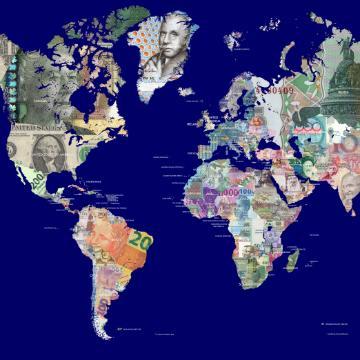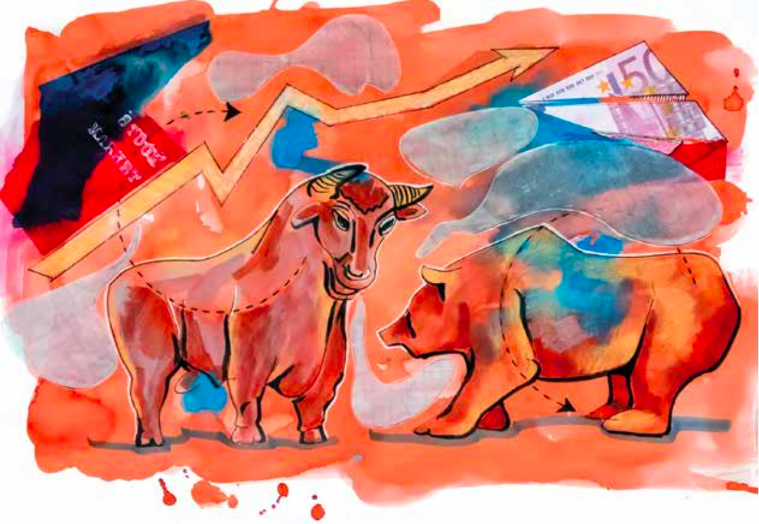
The Moral Margins of Poverty and Prosperity: Toward an Integrative Justice Model in Business
Excerpt from 2017 Bannan Memorial Lecture1

By Nicholas Santos, S.J.
Assistant Professor of Marketing
College of Business Administration
Marquette University
One might assume that the booming tech industry in Silicon Valley is a sign of prosperity. Unfortunately, it is also the cause of rising poverty. Extremely high rent costs and the increased cost of living push many people into the poverty bracket.
The Department of Health and Human Services in its 2017 poverty guidelines shows the poverty threshold for a household with four persons to be $24,600. Interestingly, the level for Hawaii is $28,290 and for Alaska is $30,750. But even the Alaska threshold is still very low compared to Silicon Valley. A recent article by Olivia Solon in The Guardian reveals that many tech workers earning six-figure annual incomes feel poor in the Valley. If that is the case, what about those who do not earn six-figure incomes? The high cost of living in Silicon Valley is not only contributing to an increase in poverty and homelessness in the region, but it is also having a spillover effect on neighboring rural areas in the Central Valley, such as Patterson and Modesto, California.
Previous speakers in the Bannan Institutes, such as Matthew Carnes, S.J., and Professor William Sundstrom, have pointed out the economic inequalities of our present times. In January 2016, a few weeks prior to Fr. Carnes’ address, Oxfam International highlighted in its briefing report that in the year 2015, 62 individuals owned the same amount of wealth as 3.6 billion people, or half of the world’s population. In January 2017, a few weeks prior to Professor Sundstrom’s talk, Oxfam updated its findings with new and more accurate data showing that instead of 62 people, it was just eight men who owned the same amount of wealth as 3.6 billion people. The immensity of this disparity is astounding. So much so that the issue of inequality featured at the center of the discussions at the World Economic Forum in Davos, Switzerland, earlier this year. While the number of people living in extreme poverty fell below 10 percent in 2015, the unfortunate reality of our time and of our common home is that a substantial number of people around the world struggle to make ends meet and lack adequate nutrition, access to education, sanitation, clean water, and even shelter. These people constitute what has been labeled the “base or bottom of the pyramid” segment.

Barry Pisetzner, “Drowning Minorities,” acrylic and pencil on canvas, 12” x 16”. Used with permission of the artist.
Traditionally, marketers shied away from this population; they were perceived to have little purchasing power and thus constituted an unattractive market segment. As a result, this population has not only been underserved, but also pays more for products and services—a poverty premium. Think about a 3,000 percent annualized interest rate on loans or rent-to-own products that work out to be many times more than the actual cost of the product. The impetus for multinational corporations to market to the poor is largely provided by analysis demonstrating that there is an emerging profit potential in low-income markets. The first such comprehensive argument was provided by Professors C.K. Prahalad and Stuart Hart in an article in Strategy+Business in 2002, in which, with the help of case examples, they pointed out that low-income markets provided big companies the opportunities of amassing their fortunes as well as bringing prosperity to the world’s poor. In a 2005 work titled Fortune at the Bottom of the Pyramid, Professor Prahalad claimed that the collective fortune to be made in these markets was in the vicinity of U.S. $13 trillion in terms of purchasing power parity.
Professor Prahalad made some good points, including the legitimate needs of the poor, who are both brand-conscious and underserved. However, the idea of a fortune to be made at the bottom of the pyramid is a bit troubling. If big companies are going to be attracted to this segment only because of the fortune to be reaped, there is the possibility of a greater exploitation of poor and disadvantaged consumers. Historical business involvement with low-income consumers has been rife with a plethora of unethical and exploitative practices, such as predatory lending, tainted insurance, unconscionable labor practices, and exorbitant rent-to-own transactions.
For business engagement with the poor to be fair and just to both parties (that is, the business and the consumer) but especially the poor, there needed to be a normative framework that would guide such engagement. I therefore went about developing such a framework, which has now developed into the Integrative Justice Model (IJM). In developing this model, I considered 13 different frameworks or theories. These were: (1) virtue ethics; (2) W.D. Ross’ theory of duty; (3) Jürgen Habermas’ discourse theory; (4) Immanuel Kant’s categorical imperative; (5) John Rawls’ theory of justice; (6) classical utilitarianism; (7) Amartya Sen’s capability approach; (8) stakeholder theory; (9) triple bottom line; (10) sustainability; (11) socially responsible investing; (12) service-dominant logic of marketing; and (13) Catholic social teaching.
Reflecting on the notion of “fairness” or “equity” in marketing transactions involving impoverished populations from the perspective of these 13 frameworks, five key elements emerged:
- Authentic engagement with consumers, particularly impoverished ones, with nonexploitative intent
- Co-creation of value with customers, especially those who are impoverished or disadvantaged
- Investment in future consumption without endangering the environment
- Interest representation of all stakeholders, particularly impoverished customers
- Focus on long-term profit management rather than short-term profit maximization

Ariadna de Raadt, “Finance & Crises,” ink. Used with permission.
Instead of discussing the theoretical derivation of these key elements, I would like to briefly elaborate on each of them.
1. Authentic engagement
The corporate scandals at the turn of the century, the financial meltdown in 2008, and continued corporate abuses like the Volkswagen emission case contribute to a fundamental breakdown of trust in the business-consumer relationship. An important means of restoring this trust, particularly with impoverished consumers, is through engaging them with non-exploitative intent. An authentic engagement is one that possesses the intrinsic quality of being trustworthy as well as a process that aims at winning the trust of the constituents engaged. In his book, Globalization from the Bottom Up, Professor Samli makes the distinction between greed and ambition. Companies motivated by greed will attempt to win in any way, shape, or form; get as much for themselves as they can and move as fast as they can get it, paying little heed to the external environment. In contrast, an ambitious company realizes that working and collaborating with others increases opportunities for progress and benefits a larger number of people. The Aravind Eye Care System in India, whose mission is to eradicate needless blindness by providing appropriate, compassionate, and highquality care for all, is a good example of an organization that authentically engages consumers without intending to exploit them.
2. Co-Creation of value
Co-creation of value is an emerging approach in marketing, which holds that, instead of autonomously positing what constitutes value for consumers, a business firm ought to involve such consumers in the value-creation process itself. One of the easiest ways to generate creative and ethical symbiosis and avoid negative outcomes is to partner with impoverished customers from the beginning. For example, Amanz’ abantu Services, a South African provider of water and sanitation services, involves consumers from the beginning of the innovation process itself. A direct inquiry process conducted during the incubation phase enabled customers to select the design of the sanitation structure. Additionally, rural, community-based village groups called project steering committees were set up to enable the villagers to play an active role in the project’s design and implementation, thereby leading to greater ownership. Such an open innovation paradigm grants consumers the role of “prosumers,” integrating them actively and deeply in one or—ideally—all stages of the innovation process (invention, incubation, market introduction, and diffusion).
3. Investment in future consumption
One of the fears of expanding marketing to impoverished market segments, particularly in developing countries, is that an exponential increase in overall consumption could have dire consequences on an already battered planet. However, a major assumption made is that present production patterns will be used to support such expansion, and this need not be the case. There are numerous examples of disruptive innovations, such as solar energy and mobile phones. For instance, mobile phones have enabled poor consumers in rural areas to have access to modern technology and have eliminated the need to set up phone cables and connections in these areas. But the investment in future consumption should be seen as encompassing more than merely proposing a budget for increasing consumption. It is linked with Amartya Sen’s idea of expanding the capabilities and freedoms of people and is proposing a better participation of the impoverished in the market system.
4. Interest representation of all stakeholders
In a book chapter titled “Globalization and the Poor,” Harvard researchers V. Kasturi Rangan and Arthur McCaffrey argue that one of the reasons why the trillions of dollars spent on development aid have hardly made a dent in global poverty is because the interests of the poor were never sufficiently considered. In addition to the interests of shareholders, companies need to consider the interests of other stakeholders, particularly those who do not have much voice in the economic negotiation process. Considering the interest of the often-voiceless impoverished consumer is in accordance with the principle of the common good and the principle of subsidiarity.
5. Focus on long-term profit management
Catholic social teaching (CST) recognizes the legitimate role of profits in the functioning of the business enterprise. However, a preoccupation with profitability, ironically, can act against the long-term interests of the business organization. Such a preoccupation is largely the outcome of a short-term mentality that is driven by quarterly profit increments or even annual ROI targets. The pressure for short-term profit maximization can lead to various forms of unethical business behavior, as evidenced by the corporate scandals that continue to erupt. According to CST, the individual profit of a business enterprise should never become the sole objective of a company. Rather, it should be considered together with another equally fundamental objective, namely, social usefulness. A company is more likely to consider its social usefulness when it has a long-term rather than a short-term perspective. If companies are intent merely on short-term profit maximization, they will be, first and foremost, reluctant to enter impoverished markets because of the low purchasing power of these consumers and the various barriers to entry, such as inadequate infrastructure, lack of knowledge of these markets, etc. Secondly, because so many in impoverished segments have low literacy and minimal economic choices and education, corporations will be tempted to indulge in exploitative practices that further disadvantage the impoverished customers. Instead, if companies take a longterm profit management perspective, they will view these markets as “a source of opportunity, innovation, and competitive advantage.” Further, they will be less prone toward being exploitative, as it makes little sense to exploit a segment whose growth is vital to the company’s own long-term success. Taking the long-term view also enables a company to support local communities in their holistic development, as such development is beneficial to the company in the long run.
I began with highlighting the issue of inequality. However, inequality isn’t the underlying issue. The underlying issue is fairness. I hope that the Integrative Justice Model (IJM) inspires business practitioners and social entrepreneurs to reflect on the conditions of a marketplace that presently include too many vulnerable people who lack bargaining power. Whether they are residents of rural India, a Brazilian favela, or a recent U.S. immigrant scraping together a coach fare for a visit back home to see an elderly parent, they require the assurance of fairness when securing their economic needs. The IJM represents some essential ideals of fair exchange against which current selling practices to poor consumer segments can be measured. Awareness of the IJM is a small and hopefully helpful step for those involved with impoverished customers in aiding that process.
NICHOLAS (NICKY) SANTOS, S.J., is assistant professor of marketing at Marquette University, a Jesuit priest, and co-director of the University’s social innovation initiative as well as co-chair of the Catholic Relief Services (CRS) Global Campus initiative. He has degrees in philosophy, theology, and business. After earning his Ph.D., he spent three years at Santa Clara as a postdoctoral fellow and visiting scholar at the Markkula Center for Applied Ethics, program chair for the Global Social Benefit Incubator Network workshop, and reviewer for the Global Social Benefit Fellowship with the Miller Center for Social Entrepreneurship. He has published widely in a number of business journals such as the Journal of Public Policy and Marketing, Journal of Business Ethics, Business & Politics, Journal of Macromarketing, Journal of Marketing Management as well as in mission-related journals such as the Journal of Catholic Social Thought, Journal of Jesuit Business Education, and Journal of Management for Global Sustainability.
Notes
- Nicholas Santos, S.J., “The Moral Margins of Poverty and Prosperity: Toward an Integrative Justice Model in Business,” Bannan Memorial Lecture, 2016–18 Bannan Institute series, May 2, 2017, Santa Clara University. This essay is an excerpt from the lecture; a video of the full lecture is available online: scu.edu/ic/media--publications/video-library.
| Powering Forward Toward Racial and Ethnic Justice in Our Common Home | Home | Economic Justice: Fairness in Context |